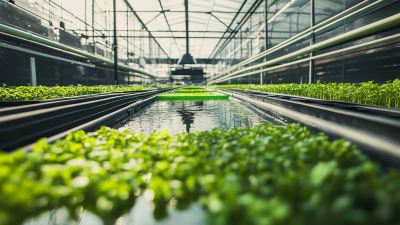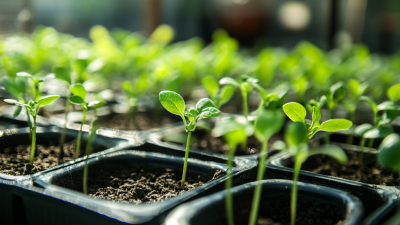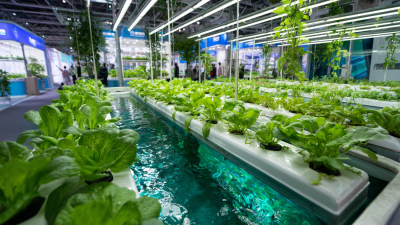
Maximizing Crop Yields in Tunnel Greenhouses: Insights from Recent Agricultural Studies
In recent years, tunnel greenhouses have emerged as a pivotal innovation in modern agriculture, allowing for the maximization of crop yields through controlled environmental conditions. These structures offer farmers the ability to cultivate a diverse array of crops year-round, effectively mitigating the adverse effects of weather variability and pests. As agricultural studies increasingly highlight the benefits of tunnel greenhouses, understanding the best practices for their management becomes indispensable for optimizing production efficiency.
Recent research has shed light on various techniques that enhance plant growth and productivity within tunnel greenhouses. From precise irrigation strategies to the implementation of advanced soil management practices, these studies reveal critical insights that farmers can adopt to elevate their yields. Moreover, the integration of technology, such as climate control systems and monitoring tools, has proven essential in creating the ideal growth environment for crops.
As we delve into the current findings surrounding tunnel greenhouses, it becomes evident that a combination of innovative agricultural practices and research-backed strategies can significantly contribute to food security. By maximizing crop yields in these versatile structures, farmers not only enhance their livelihoods but also play a crucial role in addressing global agricultural challenges.

Best Practices for Soil Management in Tunnel Greenhouses
Effective soil management is crucial for maximizing crop yields in tunnel greenhouses. Recent studies indicate that optimizing soil health can significantly enhance plant growth and productivity. According to the "International Journal of Agricultural Research," proper nutrient management can lead to a 20-30% increase in yield. This underscores the importance of regular soil testing to monitor nutrient levels and adjust fertilization accordingly.
Tip: Implement a rotational cropping system to improve soil fertility. Alternating between deep-rooted plants and shallow-rooted plants can help restore essential nutrients and prevent soil depletion.
In addition to nutrient management, soil structure is a key factor that influences water retention and aeration, both of which are vital for root development. Research from the "Journal of Sustainable Agriculture" suggests that incorporating organic matter, like compost or well-rotted manure, can enhance soil structure and microbial activity, leading to healthier plants.
Tip: Mulch your soil with organic materials to reduce evaporation and maintain moisture levels while suppressing weeds, promoting a conducive environment for crop growth.
Optimizing Microclimate for Enhanced Crop Growth
Recent agricultural studies have revealed that optimizing the microclimate within tunnel greenhouses can significantly enhance crop growth and overall yields. By carefully managing factors such as temperature, humidity, and light, growers can create an ideal environment for plant development. Monitoring and adjusting these variables allows for more consistent growing conditions, which is crucial for maximizing productivity throughout varying seasonal climates.
One effective strategy employed by researchers is the integration of advanced climate control technologies. These include automated systems that regulate ventilation, shading, and irrigation based on real-time data. For example, smart sensors can measure not only the ambient temperature but also leaf temperature and soil moisture levels, enabling precise adjustments that promote optimal conditions for plant health. In addition, the use of reflective materials can increase light availability while minimizing heat buildup, further supporting enhanced growth rates. By focusing on microclimate optimization, farmers can not only increase yields but also reduce reliance on chemical inputs, leading to more sustainable agricultural practices.
Advanced Irrigation Techniques for Maximizing Water Efficiency
Recent agricultural studies highlight the pivotal role of advanced irrigation techniques in enhancing water efficiency within tunnel greenhouses. These structures, designed to create a controlled environment, allow for the precise management of water resources, which is increasingly critical as climate variability poses challenges to traditional farming methods. Employing drip irrigation systems, for example, enables water to be delivered directly to the plant roots, minimizing evaporation and runoff. This targeted approach not only conserves water but also improves plant health by ensuring optimal moisture levels.
Moreover, the integration of automated irrigation technologies, such as soil moisture sensors and weather-responsive systems, can significantly enhance water management in tunnel greenhouses. These innovations allow farmers to monitor soil conditions in real-time and adjust irrigation schedules accordingly. As a result, crops receive the exact amount of water they need, reducing waste and promoting sustainable farming practices. This synergy between technology and agriculture is crucial for maximizing crop yields while maintaining water efficiency, which is essential for future food security.
Maximizing Crop Yields in Tunnel Greenhouses: Insights from Recent Agricultural Studies - Advanced Irrigation Techniques for Maximizing Water Efficiency
| Irrigation Technique | Water Efficiency (%) | Average Yield (tons/ha) | Soil Moisture Retention (%) | Cost ($/ha) |
|---|---|---|---|---|
| Drip Irrigation | 90 | 15 | 60 | 2000 |
| Sprinkler Irrigation | 75 | 12 | 50 | 1500 |
| Subsurface Irrigation | 85 | 18 | 70 | 2500 |
| Fog Irrigation | 95 | 20 | 80 | 3000 |
Utilizing Integrated Pest Management to Improve Yields
Integrated Pest Management (IPM) is increasingly recognized as a vital strategy for maximizing crop yields in tunnel greenhouses. Recent studies highlight that the adoption of IPM practices can lead to yield increases of up to 20%, as reported by the International Journal of Agricultural Research. By combining biological control methods, cultural practices, and targeted chemical interventions, growers can minimize pest populations while maintaining a healthy ecosystem. This approach not only enhances crop resilience but also fosters sustainable farming practices.
Moreover, research indicates that tunnels modified for IPM can reduce pesticide application rates by 50% without compromising yields. The increased biodiversity and introduction of beneficial insects can naturally regulate pest populations, which reduces dependency on synthetic treatments. According to a 2022 report from the Food and Agriculture Organization (FAO), farms employing IPM strategies are better positioned to withstand adverse climatic conditions, ultimately leading to more stable production cycles. As the agricultural sector faces growing challenges from climate change and pest resistance, integrating IPM in tunnel greenhouses emerges as an essential practice for sustainable and profitable farming.
Innovative Crop Rotation Strategies for Sustainable Production
Innovative crop rotation strategies have gained attention as a vital tool for sustainable production, especially within the context of tunnel greenhouses. Recent agricultural studies highlight the efficacy of integrating diverse crops such as corn and soybeans, a practice favored by Iowa farmers. This method not only enhances overall yields but also significantly reduces nitrous oxide emissions, aligning agricultural practices with climate-smart strategies. By implementing such rotations, farmers can optimize soil health and fertility, leading to resilient crop systems capable of withstanding environmental challenges.
In South Africa, the adoption of climate-smart food systems emphasizes the importance of integrated approaches to agriculture. This method focuses on not only improving yields but also mitigating greenhouse gas emissions through innovative practices. Research shows that diversifying crop rotations not only increases food production but also contributes to sustainability goals by enhancing biodiversity and improving soil quality. These insights underline the transformative potential of crop rotation strategies in promoting an environmentally sustainable future while also meeting the increasing global food demand.
Maximizing Crop Yields in Tunnel Greenhouses: Innovative Crop Rotation Strategies
Related Posts
-

Innovative Advantages of Tunnel Greenhouses for Sustainable Agriculture
-

8 Innovative Strategies for the Best Aquaponics Greenhouse Success
-

Unlocking Quality Supply Chains for Your Best Gothic Greenhouse Needs
-

Innovative Solutions for Optimal Agricultural Greenhouse Performance
-

China’s Resilient Growth in Manufacturing: The Rise of the Best Blackout Greenhouses Amidst Tariff Challenges
-

Exploring the Future of Aquaponics Greenhouses at the 138th China Import and Export Fair 2025
